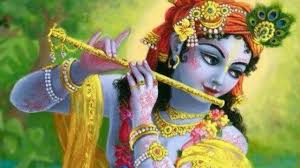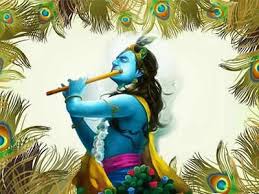
THE ENCHANTING FLUTES OF LORD KRISHNA
Lord Krishna, the 8th incarnation of Vishnu, is a prominent deity in Hinduism and one of the most revered figures in Indian mythology and spirituality. Krishna's character is rich in symbolism and meaning, inspiring millions who seek spiritual growth, love, and enlightenment. Often depicted with a flute in his hand and a peacock feather on his head, Krishna’s flute serves not just an aesthetic or romantic purpose but holds immense spiritual symbolism.
The Mystical Flutes of Krishna
According to Srimad Bhagavatam, Krishna learned to play the flute by himself, while other texts like the Brahma Samhita narrate that the flute was given to Krishna by Lord Shiva and Goddess Saraswati, with Shiva even teaching Krishna how to play it. In the Brahma Samhita, it is explained that Lord Krishna possesses various flutes, each designed for specific purposes. Here are three distinct types of flutes utilized by Krishna:
-
Venu
This diminutive flute measures no more than six inches in length and has six holes for producing melodies. When Krishna plays the Venu, a remarkable phenomenon occurs – all four Vedas present themselves before Him, drawn by the divine vibrations emitted by the sound of the Venu. Known as “Venu Naatham,” Krishna plays the Venu on Ekadasi days to provide spiritual strength to saints and sages. The soundwaves produced by the Venu are regarded as equivalent to the nectar of immortality, Amrutham. On Ekadasi, only those sages devoutly worshipping Krishna have the privilege of hearing the rhythmic melodies of the Venu in the air, a phenomenon referred to as “Krishnadhwani,” or the voice of Krishna.

-
Murali
Measuring approximately eighteen inches, the Murali flute has a hole at the end and four additional holes along its body, producing an exceptionally enchanting melody. Krishna, also known as “Muralidhar” (one who holds the flute), and “Murari” (the remover of enmity), plays the Murali during cosmic dissolution (pralaya kalam) and in response to the prayers of His devoted followers who long to hear its divine melody. When Krishna plays the Murali, even Lord Shiva and Parvati come to relish its enchanting sound, making it a manifestation of pure and divine music.

-
Vamsi
The Vamsi flute, approximately fifteen inches long with nine holes, produces an enchanting melody that resonates in all four directions. Remarkably, although Krishna’s flute music is produced within our physical universe, its sound transcends cosmic boundaries and penetrates the spiritual realm. This celestial vibration enters the ears of all living beings and holds a special allure for Goloka Vrindavan Dhama, Krishna’s divine abode. The sound captivates the hearts and minds of the young damsels of Brajbhumi, irresistibly drawing them to Krishna’s presence.

The Symbolism of Krishna's Flutes
Krishna’s flutes were often decorated with jewels and made from hollow bamboo. When made of gems and adornments, the flute is called Sammohini, and when made of gold, Akarsini. Krishna also has a flute named Mahananda, like a fish hook that captures the heart and mind of Srimati Radha. His flute with six holes is known as Madanajhankrti, and the Sarala flute makes a soft tone like a cuckoo bird, often played in the ragas Gaudi and Garjari.

The six holes of the Venu correspond to the body’s chakras, while the five holes of the Murali represent the sensory organs, and the nine holes of the Vamsi symbolize the body’s pores. This makes the flute a reflection of the body, suggesting that to connect with the divine breath, one must first rid themselves of vices and ego. Practitioners like Subir Ray equate the six holes of the Venu with the six human vices (lust, anger, greed, attachment, ego, and envy), which must be purged through yogic asceticism, much like holes are crafted onto a bamboo pole with hot iron rods.
Krishna's Divine Serenade
To manage his vast herd of nine hundred thousand cows, Krishna perches on a tree and serenades them with his flute. As he prepares to return home, Krishna employs the magical melody of his flute to individually summon each cow by name – Chandrika, Dhavali, Ivali, and so on. When the flute’s enchanting notes call out “Chandrika,” only Chandrika herself can discern her name and joyfully rush to Krishna’s side. This ritual repeats for each cow, ensuring that none are left behind.

Celebrating Krishna with Devotional Attire
As we celebrate Janmashtami, the birth of Lord Krishna, we can express our devotion through devotional attire. Wearing a Hanuman T-shirt, Ganesh T-shirt, Krishna T-shirt, Ganpati T-shirt, Anjaneya T-shirt, Krsna T-shirt, Lord Krishna T-shirt, T-shirt Krishna, or Hindu T-shirt is a wonderful way to honor Krishna and stay connected to the divine spirit of the festival. To buy a variety of hindu t shirts like shivji t shirt, hanuman t shirt, ganesh t shirt, Krishna t shirt, ram t shirt, bajrang bali t shirt etc. click here!
Conclusion
Lord Krishna’s relationship with his flute is so unique that he is affectionately known by various names such as Venugopal, Bansilal, Murali, and Muralidhar, reflecting his profound connection with this musical instrument. Krishna's flutes are more than just instruments; they are embodiments of divine love, spirituality, and profound symbolism. As we celebrate Janmashtami, let us draw inspiration from Krishna’s divine melodies and the timeless lessons of love, devotion, and spirituality that he imparts.
[The images used in this blog post are not owned by Anime Devta, they are just for entertainment purposes]
| JANMASHTAMI | LORD KRISHNA | HINDU T SHIRT | SHIVJI T SHIRT | HANUMAN T SHIRT | GANESH T SHIRT | KRISHNA T SHIRT | RAM T SHIRT | BAJRANG BALI T SHIRT | HINDU |
~Mimansa Sharma

